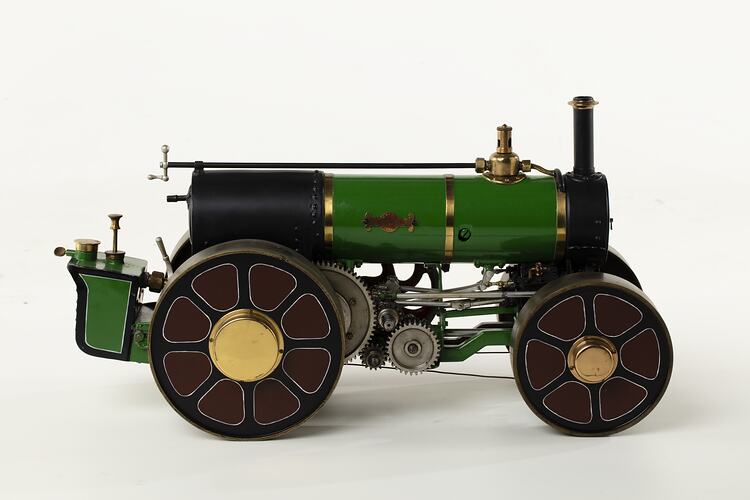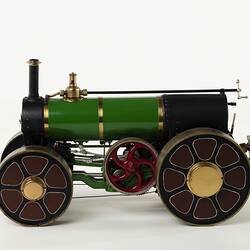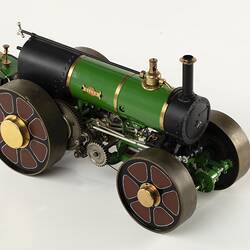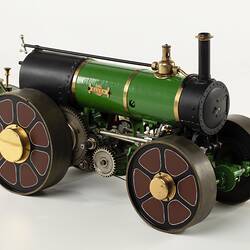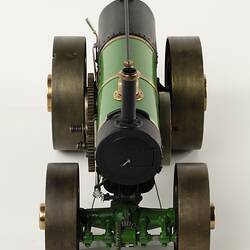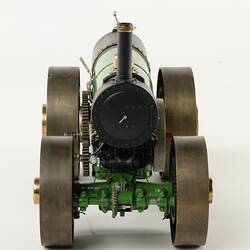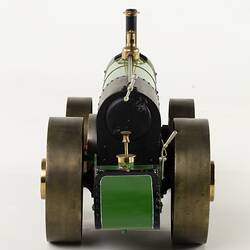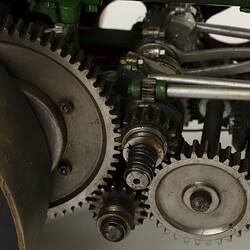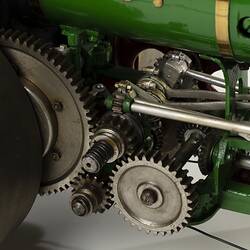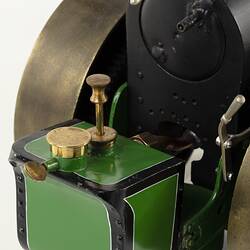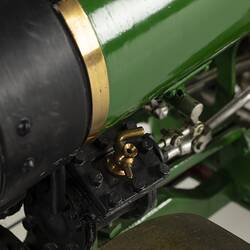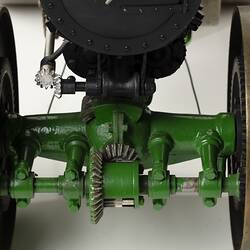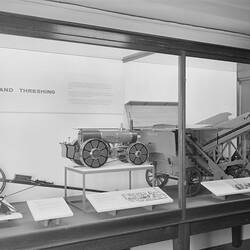Summary
Working scale model of an undertype four-wheel-drive steam traction engine with a twin-cylinder engine mounted under the boiler. Built to a designed by Thomas Quinlivan, of Coghill's Creek, Victoria, patented in 1908.
Thomas Quinlivan was born in County Clare, Ireland, in 1842, being the oldest son of Daniel Quinlivan, a farmer, and his wife Ann, née Shelton. A younger brother Patrick, was born two years later. The family arrived in Victoria as assisted immigrants on the 738 ton ship Reliance on 19th March 1850, the year before the start of the goldrushes. In 1857, Thomas's father selected 160 acres (65 ha) of land at Coghills Creek, near Learmonth, north-west of Ballarat.
On 4 March 1862, Thomas married Ellen Cavanagh (1841-1906) at the Catholic Church, Buninyong, and they had twelve children. On his father's death in 1867, Thomas inherited half the farm at Coghills Creek, and his father's steam threshing plant, which he developed into an extensive contract harvesting business, gaining a wide experience of steam engines and farm implements. Despite little in the way of formal education, Thomas had a natural mechanical aptitude and an extremely inventive mind, taking out a dozen patents for innovations relating to agricultural machinery and steam power, between 1873 and 1911.
His most ambitious and significant invention was the four-wheel-drive traction engine design that he patented in 1908. Key features of the design included an undertype steam engine, providing a low centre of gravity; enclosed road wheels that doubled as auxiliary water tanks to extend the engine's operating range; power steering; and a longitudinal drive-shaft that transmitted power to separate differentials on both the front and rear axles. The cross shaft of the front axle assembly passed through a specially designed ball and socket universal joint, allowing the axle to pivot in any direction while still maintaining power to the front wheels.
This working scale model of the design was built at a cost of £150 for Thomas Quinlivan during early 1909, to demonstrate the practicality of the invention. Components for the model were manufactured and assembled by Frank Patterson, an engineer & bicycle manufacturer, of Armstrong Street, Ballarat, based on drawings prepared by George F. Wightman, Ballarat, an engineer & draughtsman who had originally trained at the Phoenix Foundry. A public demonstration of the model was held on Friday 2nd April 1909, at Lester's Hotel, Ballarat, attended by the politicians Sir Alexander Peacock & Mr A.N. McKissock, M.L.A.s, Messrs Hornsby and Co.'s representative from England, Lieut. Colonel Greenfield and others. Apologies were sent by Mr Graham, Minister of Agriculture, and Mr Kenyon, Engineer of Agriculture, who promised to inspect the invention at a later date. The model was subsequently demonstrated at the Ballarat Exhibition, then the Sydney and Brisbane Agricultural Shows, winning a gold medal at both events, and by request was demonstrated to representatives of the Queensland Government.
In August 1909, the Lands Department commissioned the manufacture of a full-size engine to Quinlivan's four-wheel-drive design by Cowley's Eureka Ironworks, Ballarat East, at a cost of £1,250. After the firm's founder, Joseph Edward Cowley, died in January 1910, work was transferred to Johnson & Son's Tyne Foundry, South Melbourne, where the engine was completed in mid-1910. The full-size engine weighed 10 tons and was rated at 12 nominal horsepower. The completed engine was demonstrated at the Royal Melbourne Show in September 1910, before being relocated to Buffalo, South Gippsland, where it was employed in a trial of the clearing and preparation of coastal scrubland for farming. By May 1911, it was in use on the estate associated with the Maffra sugar-beet factory.
Later inventions included the application of his four-wheel-drive mechanism to motor vehicles, patented in October 1909, its subsequent adaptation as a mechanised potato harvester (see ST 036783, Potato Harvester Model) and a spark arrester, patented in 1910, that was widely used by traction engine owners throughout Victoria (see ST 034981, Spark Arrestor Model).
In late 1913, Thomas Quinlivan, sold his property at Coghills Creek, in order to move to Gippsland. As a farewell gift he was presented with a purse of 61 gold sovereigns, collected by subscription from local residents, in recognition of his contribution to their community over a period of 60 years. Quinlivan died on 24th April 1920, at Bungaree, Victoria, and was buried with Catholic rites in Learmonth cemetery.
Quinlivan's original working model of the four-wheel-drive traction engine was donated to the museum by his grandson, Edward George Quinlivan (1912-1993), of Strathmore, in 1965. The model was subsequently restored for the museum by Robert D. Ramsay, of Elwood.
Physical Description
Undertype four-wheel-drive steam traction engine with twin-cylinder high-pressure double-acting steam engine mounted beneath a conventional locomotive type multitubular boiler. The model is a working engine capable of live steaming with the boiler being fired by a liquid-fuel burner. The burner and fuel tank are incorporated into the tender attached to the rear of the engine.
More Information
-
Collecting Areas
-
Acquisition Information
Donation from E. G. Quinlivan, Jul 1965
-
Inventor
Mr Thomas Quinlivan, Coghill's Creek, Victoria, Australia, circa 1908
Inventor & Patentee. -
Draughtsman
Mr George F. Wightman, Ballarat, Victoria, Australia, circa 1908-1909
Born Thornton (Alexandra), Victoria, 1868. Died East Melbourne, Victotria, 1938. -
Modelmaker
F. Patterson, Engineer & Bicycle Manufacturer, Armstrong Street, Ballarat, Victoria, Australia, 1909
Born Ballarat, Victoria, 1872. Died Richmond, Victotria, 1934. -
Restorer
Mr R. D. Ramsay, Elwood, Victoria, Australia, circa 1965-1966
-
Brand Names
-
Classification
-
Category
-
Discipline
-
Type of item
-
Dimensions
685 mm (Length), 290 mm (Width), 370 mm (Height), 10 kg (Weight)
Approximate weight of object.
-
References
'Improved Traction Engine - A Ballarat Invention', Ballarat Star, 3 Apr 1909, p.6, from [Link 1] ; 'Personal', Table Talk (Melbourne), 8 Apr 1909, p.7, from [Link 2] ; Bacchus Marsh Express (Vic. : 1866 - 1943), Saturday 7 August 1909, page 2, from [Link 3] ; 'New Agricultural Locomotive', Wodonga & Towong Sentinel, 24 Sep 1909, p.4, from [Link 4] ; 'Coghill's Creek. New Traction Engine', The Ballarat Star, 19 Sep 1910, p.6, from [Link 5] ; [Obituary] Ballarat Star, 27 Apr 1920, p.1, from [Link 6]
[Article] Hallett, Martin L. 'Quinlivan, Thomas (1842-1920)', in Serle, Alan Geoffrey. Australian Dictionary of Biography. vol.11.
-
Keywords
Australian Innovations, Engineering Works, Foundries, Steam Engines, Steam Traction Engines, Tractors, Innovation & Design, Model Steam Engines
